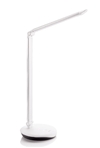- 09
- Aug
Creating a Healthy Study Environment: Intelligent Lighting Design for Children’s Well-Being and Academic Success Guide
Creating a Healthy Study Environment: Intelligent Lighting Design for Children’s Well-Being and Academic Success Guide
Myopia is the most prevalent eye condition not only in my country but also globally. It stands as the most common type of refractive error. This condition occurs when, during the adjustment and relaxation of the eyes, parallel light rays converge in front of the retina after passing through the eye’s refractive system. To put it simply, we can liken the eyeball to a camera, the eye’s refractive system to its ‘lens’ responsible for focusing, and the retina at the back of the eye to the camera’s film. In myopia, the film (retina) fails to clearly capture distant scenes, much like the camera struggling to photograph faraway objects.
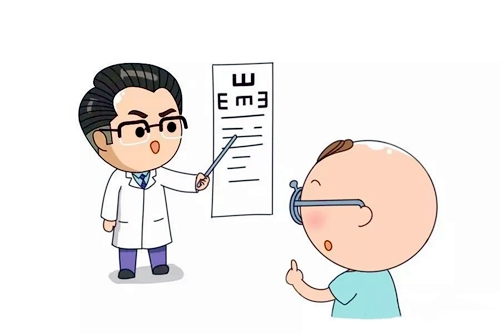
The World Health Organization (WHO) has categorized it as one of the urgent eye diseases requiring attention. Parents, often eager to address it, seek ways to tackle the issue. How does childhood myopia develop? Is it linked to parental genetics?
First and foremost, what signs should parents watch for in their children? Here are some indicators to remain vigilant about:
Close-up Focus: Children frequently bring objects, like books, electronic devices, or TV screens, extremely close to their eyes. They may even lean over while doing homework, exhibiting an inability to see clearly at a standard distance. This habit of getting too close can result in a strained and abnormal adjustment of their eye muscles, leading to blurred vision. This behavior not only fosters pseudomyopia but also accelerates visual fatigue, contributing to the onset and progression of true myopia.
Facial Expressions: Children might squint, frown, tilt their heads, or look upwards. These actions are attempts to manipulate lighting conditions. Squinting and frowning reduce the diffusion of light entering the eye, enhancing vision temporarily. Tugging at the corners of the eyes slightly alters the cornea’s curvature, affecting its refractive power. These adjustments offer short-lived improvements for those with mild myopia. Similarly, tilting and raising the head can alter the child’s refraction to some extent, providing clearer vision.
Eye Rubbing and Blinking: Myopia-related discomfort and eye fatigue from prolonged screen use may prompt children to frequently rub their eyes or blink excessively. These habits, while attempting to alleviate discomfort, can actually exacerbate myopia and astigmatism.
Unusual Behaviors: If a child’s homework appears less orderly, if they become more irritable or tired while studying, avoid greeting people, experience irritability, or have strained relationships with peers, these changes could serve as early indicators of myopia. Frustration often accompanies unclear vision.
Remaining vigilant to these signs can aid in timely intervention and care for your child’s visual health.
Secondly, it’s important for parents to understand that the causes of myopia can be categorized into congenital and acquired factors.
Innate Factors:
High Corneal Curvature: Corneal curvature, measured in diopters, typically matures around the age of three and remains relatively stable thereafter. An average corneal curvature is around 43D. However, if the corneal curvature surpasses 45D (equivalent to an additional 200 degrees on the cornea), a predisposition to myopia becomes more likely. For children with such high curvature, it’s advised for parents to closely monitor changes in the eye’s axis. Even a 1 mm increase in the eye’s axis can lead to higher myopia levels in children with elevated corneal curvature. While we can’t intervene in corneal curvature, we can vigilantly oversee and manage the growth of the eye’s axis.
Family History of High Myopia: Children with a family history of high myopia could develop myopia even before reaching six years of age. Early refractive screening is recommended to enable timely detection and treatment. In the event of myopia, controlling its growth rate is vital. This not only slows down myopia progression but also effectively prevents high myopia and its associated complications.

Intraocular Pressure: Intraocular pressure refers to the pressure exerted by the eye’s contents on its walls. It plays a role in eye axis expansion. Some children naturally exhibit elevated intraocular pressure, contributing to myopia development.
Acquired Factors:
Insufficient Exposure to Natural Light:
Natural light is essential for nurturing the eyes, stimulating dopamine release, and restraining eye axis growth. Thus, spending time outdoors to bask in sunlight becomes crucial. In situations where natural outdoor light is limited, it’s advisable to ensure indoor ambient lighting closely mimics sunlight. Given the continuous enhancement of lighting sources, upgrading home lighting contributes to myopia prevention and management.
Lighting Placement:
When light converges in front of the retina, the eye axis remains relatively stable. However, light consistently converging behind the retina signals the eye to elongate itself, aiming to approach the point of convergence, thereby causing gradual eye axis growth. When observing objects up close, the point of focus shifts backward, resulting in delayed imaging. While the lens attempts to shift the point of focus forward, it often falls short due to the tendency of the ciliary muscle-lens complex to be less engaged. Consequently, as the point of focus approaches the retina, further adjustments are abandoned once clarity is attained. This accumulation of adjustment delay over time serves as the underlying cause of myopia development due to prolonged near-field eye usage.
Hence, whether myopia arises from congenital or acquired factors, proactive myopia prevention and control yield benefits. Particularly sensitive individuals might even achieve stagnation or regression in myopia progression.
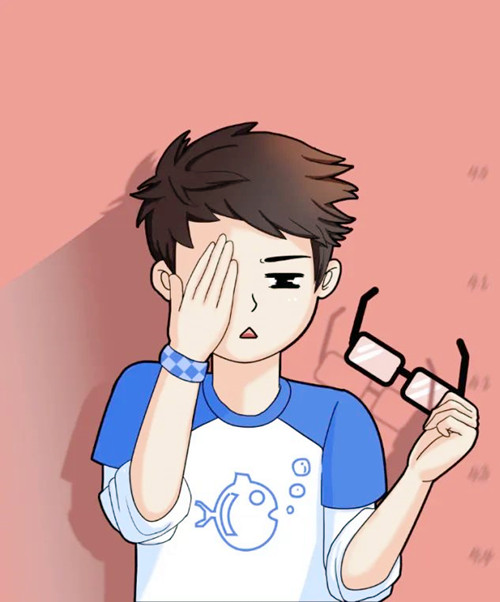
Recently, on behalf of our company, I attended the 9th Huaxia Ophthalmology International Forum held in Xiamen from May 27th to 28th, 2023. During the event, Huaxia Eye Hospital Group and the China Children’s Charity Aid Foundation unveiled two white papers: the ‘National White Paper on the Prevention and Control of Myopia in Children and Adolescents,’ and the ‘White Paper on the Epidemiological Investigation of Eye Diseases in Fujian Province.’
The ‘National White Paper on the Prevention and Control of Myopia in Children and Adolescents’ is based on effective eye health screening data from 4,027 full-time ordinary primary and middle schools across 19 provinces and 51 cities, covering the period from 2019 to 2021, and encompassing a total population of 4.556 million.
The study’s findings revealed that the prevalence of screened myopia among the primary school population was 54.00%, rising to 78.18% in junior high school and 87.05% in high school. Myopia’s prevalence was found to be higher in girls compared to boys, as well as higher in the right eye compared to the left. The prevalence of myopia increased progressively with age, with the most rapid increase seen during the junior high and high school stages, eventually stabilizing.
Research has confirmed a significant correlation between myopia prevalence and variations in school age. This link can be attributed to the increasing academic demands and near-work activities as students progress through their education. Simultaneously, the growing exposure to electronic devices as students age has led to increased eye strain. Multiple factors have converged to exert undue pressure on the eyes.
Regional analysis reveals a ‘high in the east and low in the west, high in the north and low in the south’ pattern of myopia incidence, accompanied by notable urban-rural disparities. It’s postulated that factors such as regional economic levels, the integration of electronic products in education and daily life, and environmental conditions contribute variably to myopia occurrence and progression.
In recent years, the proliferation of electronic devices has contributed to an earlier onset of myopia. The rising myopia rates among children and adolescents have raised concerns among parents.
To address this, our focus lies in light control, which falls within our professional domain. In the first half of 2023, our R&D team analyzed an array of eye protection lamps based on comprehensive data. I will elaborate on these lamps shortly. This eye protection lamp is highly suitable for LED light dealers to bolster their market offerings and is also a great fit for supermarket retail.
However, I’d like to present to you the ‘Smart Lighting Essentials for Student Families.’ We will provide guidance based on holistic lighting design rather than a singular perspective.
All set? Are you ready?
Lighting Design for Student Homes – The Growing Severity of Children’s Myopia, Is the Lighting in Your Home Appropriate?
Parents with students at home will naturally experience the increasing academic pressure their children face as they enter elementary school and embark on their educational journeys. Alongside traditional written assignments, the trend of online classes taken on home computers has gained prominence. Amidst this considerable academic burden and the disregard for proper eye health practices, numerous teenagers are falling victim to myopia at a young age (refer to Figure 1). Myopia appears to have evolved into a pressing social concern. It becomes the duty of each parent to safeguard their children’s eyesight, paving the way for a promising future.

Is the lighting arrangement conducive to healthy studying habits in children? What manner of lighting design can mitigate the risks to their eyesight? How can we establish an intelligent lighting environment that benefits our children’s well-being?
1. Impact of Lighting Environment on Students
1.1 Impact of Visual Comfort on Lighting
A comfortable lighting environment can help safeguard children from visual organ disorders and myopia. Which factors in the home lighting environment pose risks to the body? Foremost, we need to address the danger of blue light. Blue light is present in most light sources, including sunlight, incandescent lamps, and LED light sources. Scientific research demonstrates that short-wavelength blue light can penetrate the lens and directly harm visual cells. Teenagers’ eyes are not yet fully developed, rendering them highly susceptible to damage from blue light hazards. Moreover, subpar lighting fixtures can lead to significant flickering, particularly in older fluorescent tubes and some lower-quality LED lamps. This flickering can even induce vomiting and contribute to various ailments.
1.2 Impact on Learning Enthusiasm and Efficiency
While a comfortable lighting environment is essential for maintaining our health, it also exerts a positive influence on our cognitive activities. For students, studying in such an environment can not only alleviate the mental strain caused by academic pressures but also ignite their passion for learning. As a result, it enhances students’ learning efficiency and their effectiveness in completing homework (refer to Figure 2). This principle also extends to office professionals working in upscale office buildings, where the light color temperature is typically set around 4000 K. Such lighting configurations create a vibrant and relaxed ambiance, fostering a sense of contentment in both body and mind, and bolstering our motivation for studying or working.
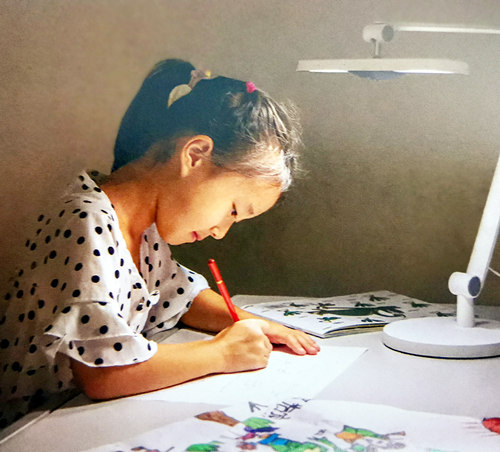
2.Mastering Principles of Environmental Lighting Design
2.1 Opt for a Professional Reading and Writing Desk Lamp
When selecting lighting for studying, it’s advisable to opt for professional reading and writing desk lamps over regular desk lamps or bedside lamps. These specialized desk lamps offer optical features such as zero video flicker and zero blue light hazard. According to national standards, lamps with frequencies exceeding 3125 Hz are considered safe as they have minimal impact on human eyes. Furthermore, the RGO grade desk lamp, evaluated as having the lowest level of blue light hazard, stands out as an excellent choice among professional desk lamps.
Given that desk lamps are in closer proximity to individuals than other types of lamps, it’s important to avoid direct glare into the eyes. This necessitates reading and writing table lamps to ensure adequate illuminance across the reading and writing area while also positioning the light source at a distance from the observer’s eyes. This arrangement achieves the effect of “illumination without glaring” (see Figure 3), which significantly contributes to safeguarding the eyesight of young individuals.

2.2 Transitioning Between Reading, Writing, and Computer Modes
With the array of learning methods available to students today, studying at home can involve completing written assignments or participating in online classes using computers. While parents often focus on the desk lamps their children use for homework, they might overlook the fact that professional lamps can also enhance computer usage. Similarly, when working from home, we frequently use computers. However, using a desk lamp for reading and writing can lead to screen reflections and uneven desktop illumination beneath the computer. Prolonged periods of looking at the computer screen can result in visual fatigue.
Employing a professional computer screen hanging lamp can mitigate screen reflections and provide consistent desktop lighting (refer to Figure 4. Therefore, when devising an intelligent lighting scheme suitable for students or home office workers, it’s important to incorporate both a “reading and writing mode” and a “computer mode.” This approach ensures a comfortable lighting environment for both studying and working, catering to varying needs.
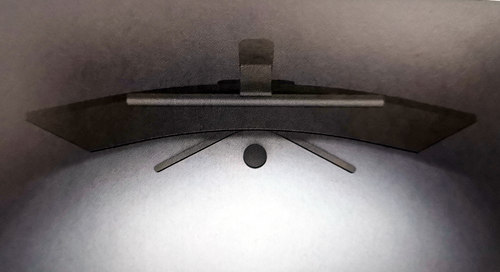
2.3 Ensuring Consistent Desktop Illumination
Maintaining the right level of illumination on the desktop is crucial, as excessive or insufficient lighting can lead to visual fatigue. According to architectural lighting standards, a minimum illuminance of 500 lux is recommended for tasks that require precise work (see Figure 5). Equally significant is the uniformity of illumination. Uneven lighting can strain the eyes and contribute to visual fatigue.
When selecting desk lamps or screen hanging lamps for students, you can consult the “Performance Requirements for Reading and Writing Homework Desk Lamps” guidelines. As per these regulations, for the central and edge areas where reading and writing activities occur, the lamps must meet at least Class A standards in terms of both illuminance and uniformity. Premium table lamps should strive for Class AA standards to provide an optimal lighting experience.
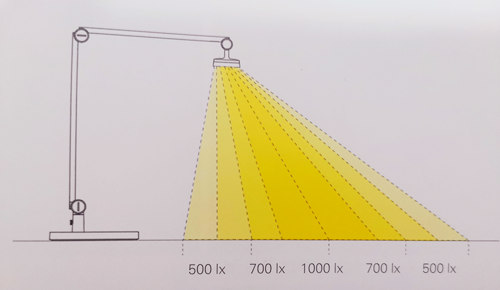
2.4 Recognizing the Role of Ambient Light
While many parents emphasize the importance of having their children switch on their desk lamps, they often overlook the significance of ambient lighting. In reality, an optimal lighting experience is the result of a harmonious interplay between effective ambient lighting and appropriate reading and writing illumination. When there’s a stark contrast in brightness between the reading and writing light and the surrounding ambient light, it can lead to eye fatigue.
This challenge can be addressed through the use of light-sensing smart desk lamps. These lamps not only address questions like “Is the ambient light suitable?” and “How bright should the desk lamp be?” but also possess a built-in light sensor. This sensor enables the smart desk lamp to gauge both the ambient light and the reading and writing light, and consequently suggest suitable brightness levels for reading and writing based on changes in the surrounding light conditions.
However, it’s important to note that while an excellent lighting environment can significantly reduce the likelihood of myopia, it cannot guarantee its prevention entirely. To mitigate myopia risks, it’s essential to increase outdoor activity time, maintain a healthy work-rest balance, and manage screen time on devices like mobile phones and TVs.
2.5 Opt for Lamps with a High Color Rendering Index
The color rendering index (CRI) of a lamp signifies its ability to accurately reproduce object colors. Sunlight has a CRI of 100, and the closer a light source’s CRI is to this value, the better its color rendering capabilities. During the student phase, children often engage with books and toys showcasing a spectrum of vibrant colors. Favorable color rendering significantly aids children’s visual cognition by presenting colors more faithfully.
Lamps with a high color rendering index emulate the performance of natural light more closely. This similarity results in more comfortable and visually appealing lighting experiences, making them particularly suitable for children’s needs.
3. Essential Smart Lighting Modes for Student Homes
3.1 Reading and Writing Mode: Cultivating an Ideal Work Environment
In the realm of daily studies and life, a significant portion of students’ time is dedicated to reading and writing assignments. Consequently, it becomes paramount to establish a comfortable illumination setting for these tasks, thus safeguarding children’s eye health. Illustrated in Figure 6, apart from ambient light sources like ceiling fixtures within the study area, it is crucial to equip students with an intelligent light-sensing reading and writing desk lamp. The hallmarks of an outstanding desk lamp include the absence of video flicker, a high color rendering index, and a blue light hazard level of RGO grade.

The distinctive feature of light-sensing desk lamps, when compared to conventional desk lamp products, is their keen attention to our desk-specific usage patterns. By incorporating advanced optical and software system design, these lamps autonomously adjust the light source’s brightness and color temperature. This automation not only enhances user comfort but also eliminates the need for manual adjustment, saving time and effort.
3.2 Computer Mode: The Ideal Solution for Computer Lighting
In the present scenario, where students devote more time to online classes within their homes, screen hanging lights emerge as a versatile solution for addressing computer lighting needs (refer to Figure 7). A screen hanging lamp effectively illuminates the display area, tackling issues related to screen reflections. Additionally, it provides optimal illumination for desktop work or office tasks. The specialized light pattern it emits negates the necessity of adjusting a desk lamp repeatedly to ensure even desktop lighting. This means that students and office workers can comfortably take notes while concurrently engaging with their computer screens.

4. Step-by-Step Guide to Crafting an Exclusive Lighting Environment for Students
Step 1: Illuminate with Purpose
Begin by strategically designing lighting fixtures. Draw inspiration from the layout of children’s rooms to guide the placement of ambient lighting. The primary focus should revolve around providing students with a dedicated professional reading and writing desk lamp for their study area. In addition, assess the situation and opt for a suitable computer screen hanging lamp as needed.
Step 2: Procure Lamps and Smart Linkage Equipment
Refer to Table 4.4 for a comprehensive list of relevant parameters detailing the attributes of read-write desk lamps and screen hanging lamps. This information serves as a reference point to guide your selections.
|
Lamp Name |
Lamp Size (MM) | Power (W) | Color Temperature (K) | Quantity(PCS) |
Lamp Picture |
| 322*468*425 | 12 | 3000-5000 | 1 |
|
|
| Smart Screen Hanging Light | Φ23*448 | 5 | 2700-6500 | 1 |
|
Step 3: Establish Lighting and Smart Linkage Protocols
(1) Integrate Devices with the Smart Home System
Adhere to the product instructions to seamlessly integrate the selected lamps into your smart home system.
(2) Monitor Ambient Light
Upon enabling the light sensing feature of the desk lamp, an indicator light will signal the suitability of the current ambient light. A green indicator light signifies comfort, while red indicates the need for adjustments. These notifications are also accessible through the mobile app.
(3) Implement Time Management Mode
Whether you’re a student immersed in studies or an office worker tackling tasks, striking a balance between work and rest is paramount. Furthermore, students in lower grades are in the crucial stage of forming learning habits, making time management awareness and habit cultivation pivotal for enhancing learning efficiency. The mobile app offers five distinct time management modes tailored to various scenarios, accommodating the diverse needs of both students and office professionals.
LEDER has introduced a range of eye protection lamps this year, including downlights, chandeliers, floor lamps, table lamps, and bedside lamps. Today, I would like to recommend a smart floor lamp.
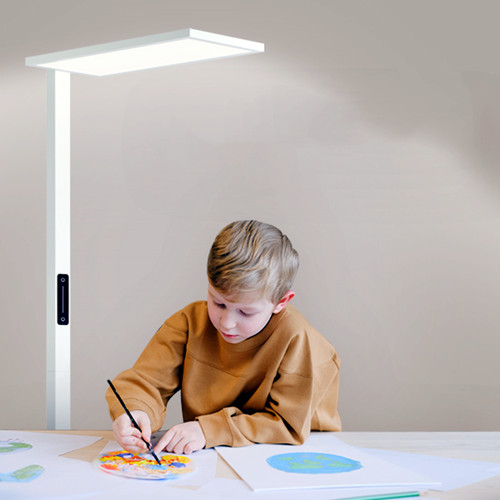
This eye-protecting floor lamp offers a remarkably close approximation to the full spectrum of sunlight, creating a natural light ambiance for your study environment and nurturing healthy eyeball development. With CRIs of 98 (Ra), 95 (R9), 98 (R1-R5), and 3 (SDCM), it faithfully restores true colors and intricate details, enhancing accuracy and visual representation.
The spectrogram of the smart floor lamp is derived from testing conducted in the LEDER lighting laboratory. The data reveals the incorporation of beneficial light across all spectral bands, replicating the characteristics of natural light rays. This design enables children’s eyes to engage with a healthier light environment that spans from visual perception to physiological response, thereby reducing the risk of myopia.

- Reduce the intensity of peak blue light to minimize photosensitivity in the retina.
- Enhance cyan-blue light to encourage relaxation of the eye muscles.
- Optimize long-wave red light to increase color saturation.
- Refine short-wave green light to effectively alleviate eye fatigue.
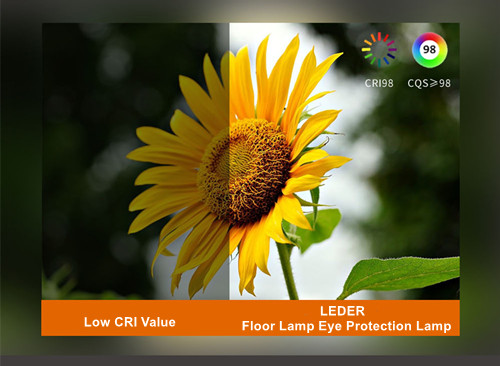
With a high rendering index of CRI98 and excellent light color quality of CQS≥98

Light-emitting surface: 1500 cm², effective illuminated area: 9600 cm², showing a 30% year-on-year increase in luminous coverage.

Wide-angle distribution of light both upwards and downwards:
- Beam angle: 90°
- The upper part provides ambient lighting, while the lower part serves as the primary
- light source for the desktop.
- The side lighting angles diffuse soft light, eliminating pen shadows, without creating shadows or glare.
Crafting a meticulously calibrated [light] for children, ensuring an illuminance of ≥ 1000 LUX and uniformity of ≤ 1.5. We’re reshaping the lighting environment, enabling continuous learning for children, and bringing the essence of natural skylight into their homes.
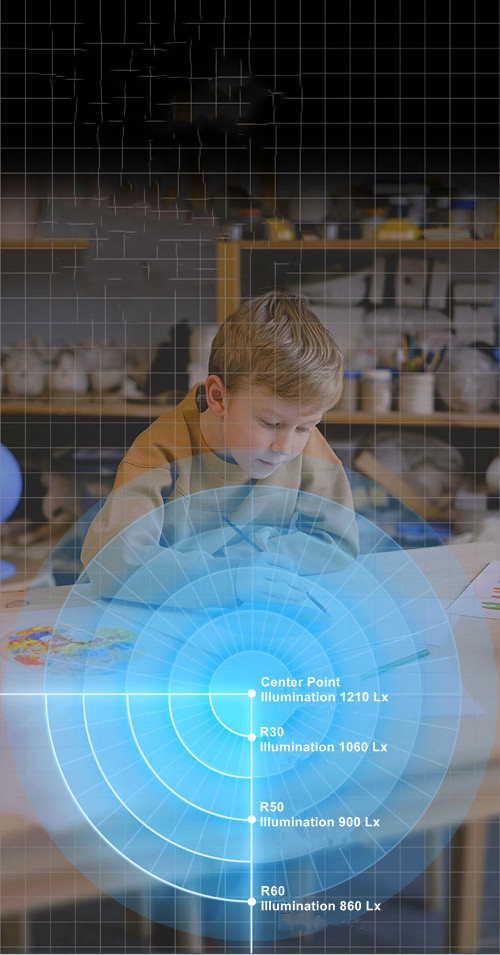
Employing triple anti-glare technology, UGR16 eliminates the risk of glare. It integrates micro-prism and diffuse reflection design for scientifically uniform light distribution, providing even and soft illumination. This ensures a comfortable viewing experience.
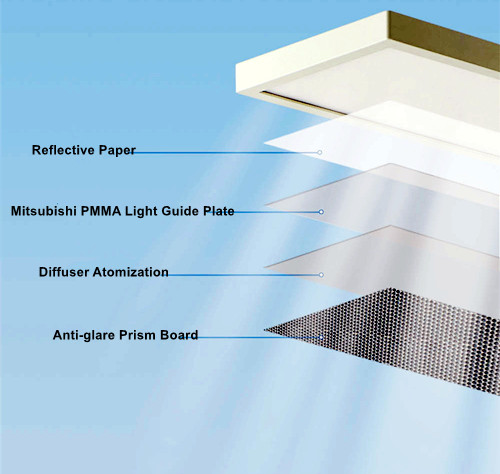
The smart floor lamp utilizes a high-density prism plate to filter light. Countless prisms refract and intersect the internal light, simulating the effect of gentle natural sunlight. The resulting spectrum closely resembles sunlight, offering a more natural lighting experience. This reduced reflected light minimizes the presence of hand shadows, decreases exposure to harmful blue light, alleviates dryness and eye fatigue in children during close-up tasks, and contributes to the prevention of myopia development.
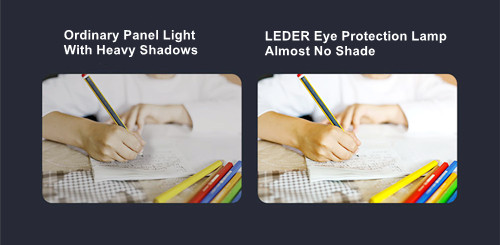
Patented No-Flicker Drive Technology:
- Fluctuation Depth ≤ 0.1%
- PSTLM Short-Term Flicker Index 1.0
- SVM Strobe Visualization Parameter ≤ 1.0
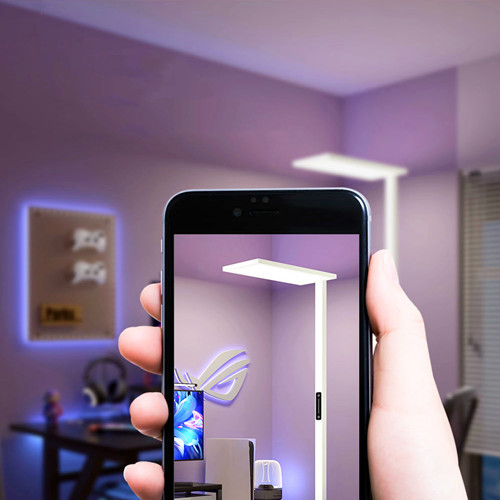
Smart Floor Lamp Details
① Rectangular panel, anti-glare prism panel
② Touch switch, high-sensitivity capacitive touch button
③Aviation aluminum material, the surface is ground and polished according to the exquisite workmanship standard of Apple and Huawei mobile phones, and sprayed with oil/powder, the touch is delicate and smooth, and no fingerprints are left.
④Thickened base, thick material, stable center of gravity, anti-dumping.
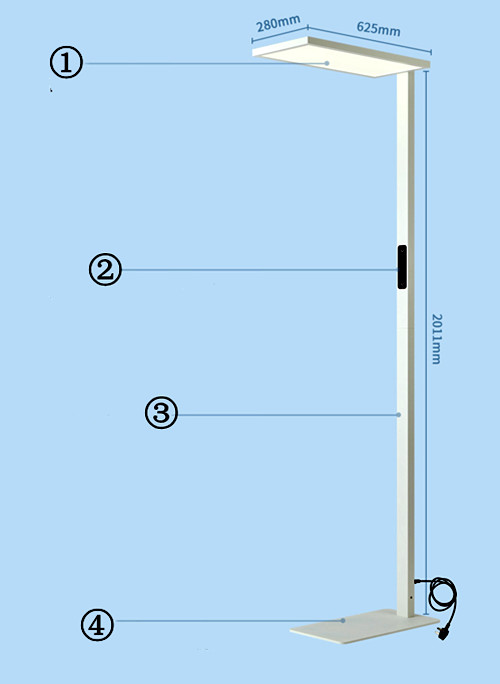
Touch-Controlled Lighting: Equipped with an integrated MCU smart motherboard and smart remote control, this system offers gradual brightening and fading, buffered lighting transitions, seamless step-less dimming, and power-off memory.
① The upper panel switch.
②The 10-level sliding dimming touch screen.
③The lower panel switch.
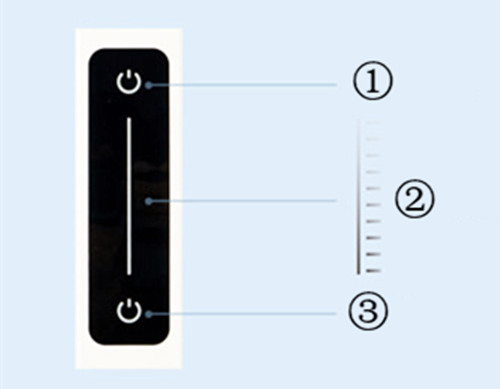
Product Specifications:
- Origin: China
- Power: 70W
- Color Rendering Index (CRI): Ra ≥ 98
- Color Temperature: Natural Full Spectrum
- Weight: 15.6KG
- Dimensions: H2011*W280*L625MM
- UGR16: Triple Anti-Glare
- Colors: Moonlight White / Galaxy Grey
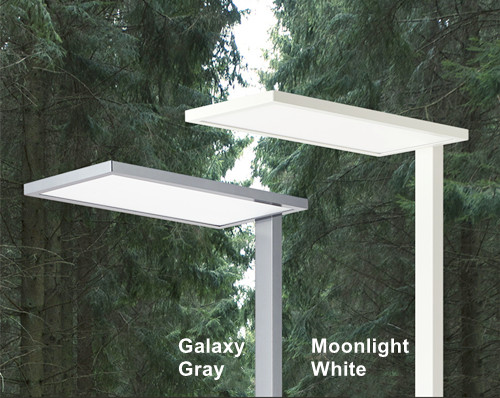

Eyes are among our most precious organs, and our ability to see is the primary means through which we perceive the world. With the shift in modern societal behaviors, myopia has been advancing steadily. The age of onset is decreasing, and its progression is accelerating. Consequently, myopia’s impact can be mitigated through prevention and control, yet its effects can also become irreversible. Hence, early prevention, timely detection, and prompt intervention are imperative.
This year, my son is 6 years old, and I discovered he had myopia when he was 5. After consulting numerous experts and doctors, I’ve summarized some key points that I hope will be beneficial to everyone:
Early Age Myopia Prevention:
Children’s eyes and vision mature over time. Newborns possess smaller eyeballs and shorter eye axes, resulting in a state of hyperopia. This is known as “hyperopia reserve,” which diminishes gradually as children grow. With eye development, eyeballs elongate, the degree of hyperopia decreases, and normal visual acuity is achieved. Inadequate hyperopia reserve, where the degree of hyperopia falls below physiological values, can lead to myopia development. Parents should be vigilant during children’s early years (1-3 years), preschool age (4-6 years), and school age (7 years and older). Establishing myopia prevention awareness, providing a healthy visual environment, and fostering good eye habits from birth are crucial.
Emphasize Daytime Outdoor Activities:
Sunlight exposure during outdoor activities stimulates the release of dopamine, supports normal eyeball development, and curbs eye axial elongation. Encouraging outdoor activities for at least 2 hours a day, or a total of 14 hours per week, is an effective, economical method for myopia prevention. Outdoor activity time correlates significantly with myopia indicators such as diopter and eye axial length. Outdoor activities should avoid peak sunlight hours and high temperatures, even on cloudy days, as they can offer protective benefits against myopia.
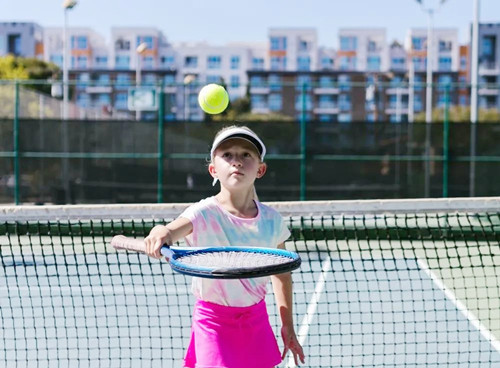
Cultivate Good Eye Habits:
Extended near-distance eye usage is a significant myopia-inducing factor. Children and adolescents should adopt favorable eye habits, including maintaining proper reading and writing distances (“one foot, one punch, one inch”), adhering to the “20-20-20” rule, and ensuring appropriate lighting conditions. For indoor lighting, leverage natural light during the day and complement it with desk lamps at night.
Manage Screen Time by Age:
Extended, close-range use of electronic screens can deplete hyperopia reserves, a critical factor behind the early and high prevalence of myopia in children and adolescents. Age-appropriate guidelines should be followed: infants and children aged 0-3 should avoid video screens, children aged 3-6 should minimize screen exposure, and primary and middle school students should limit non-learning screen time to 15 minutes per session, up to a total of 1 hour daily. Proper posture and distance are crucial for using electronic screens effectively.
Regular Eye Exercises:
Guided by traditional Chinese medicine principles, regular eye exercises help relax eye muscles, improve circulation, and alleviate eye fatigue. These exercises offer adequate rest, reduce adjustment lag, alleviate visual fatigue, and aid in myopia prevention and control. When practicing eye exercises, clean hands, proper acupoint identification, and appropriate pressure should be ensured.
Prioritize Balanced Nutrition and Sleep:
Balanced nutrition is vital for eye development in individuals aged 0-17. Encourage consumption of fish, eggs, milk, soy products, fruits, and vegetables for a diverse diet. Adequate sleep in accordance with age is essential; toddlers, elementary school students, junior high school students, and high school students should aim for a minimum of 10, 9, and 8 hours of sleep per day, respectively. Establishing consistent sleep patterns and fostering good sleep habits is essential.
Seek Professional Examination:
Parents noticing visual abnormalities, squinting, or poor vision in their children should promptly seek ophthalmological examination. Cycloplegic optometry, conducted under medical supervision, is the “gold standard” for myopia diagnosis. Parents should understand its importance and follow medical recommendations.
Diagnose and Intervene Timely:
Upon diagnosis of myopia, timely intervention and corrective measures such as wearing glasses are essential. Corrective glasses help alleviate blurred vision and slow myopia progression. Regular re-examinations are advised for preschool and elementary school children, and adjustments in glasses should be made based on individual needs. Evidence-based Chinese medicine techniques, such as auricular point pressing pills, can effectively control myopia progression under medical guidance.
Monitor High Myopia and Complications:
High myopia, exceeding 600 degrees, carries a higher risk of blinding eye diseases like cataract, glaucoma, myopic maculopathy, retinal detachment, and myopic optic neuropathy. Early prevention and control interventions are crucial to delay myopia onset and mitigate complications.
Collaborative Efforts for a Secure Future:
Addressing myopia in children and adolescents requires collaboration between government bodies, schools, families, children, and medical institutions. By prioritizing children’s eye health, we empower them for a brighter future.
Allow me to reiterate, among the ten recommendations mentioned above, I emphasize outdoor activities as the primary preventive measure.
Outdoor activities are not only the healthiest and most environmentally friendly approach but also the most scientifically proven way to prevent and manage myopia. Both domestic and international research indicates that engaging in outdoor activities for up to 3 hours a day or 20 hours a week (in a sunlight or naturally lit environment) can be highly effective in preventing myopia or slowing its progression. If meeting these time requirements isn’t feasible, maximizing outdoor activity time can still aid in myopia prevention.
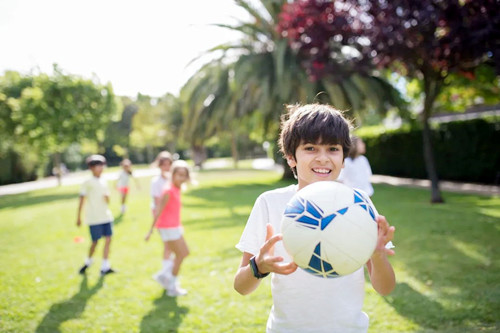
For adolescents with congenital genetic factors, it’s true that they can’t alter their genes through sun exposure. However, increased sunlight exposure can delay myopia onset and reduce the likelihood of developing high myopia in the future.
Consider this scenario: if myopia is present before the age of 10, the risk of becoming highly myopic in the future significantly increases. High myopia can lead to retinal damage, and in severe cases, even vision loss or blindness. Hence, children with congenital genetic factors should also engage in ample outdoor activities and bask in sunlight.
Increasing outdoor activities can naturally reduce children’s and adolescents’ electronic device usage. Bright outdoor light typically discourages reading or other close-range eye activities, as people tend to focus on distant objects. This relaxation of the eye muscles is beneficial for myopia prevention and control.
The eye’s reliance on outdoor activities is primarily due to the natural lighting conditions. It’s not necessary to engage in vigorous activities; simply being exposed to strong outdoor light causes the pupils to constrict, deepening the field of focus and reducing blurriness, thereby helping to prevent myopia.
Sunlight stimulates increased dopamine production in the body, which effectively hinders eyeball growth and the development of myopia.
Furthermore, sunlight prompts the body to generate more vitamin D, enhancing calcium absorption. For the eyes, this strengthens the sclera and provides better eye protection, ultimately reducing myopia occurrence and progression.
For those without myopia, “bathing” the eyes in sunlight offers the most evident preventive effect. Even for those who are already myopic, increased sunlight exposure can aid in managing myopia’s advancement.
Opt for appropriate timings to avoid strong sunlight; in summer, for instance, avoid outdoor activities during the harsh noon sun. Opt for the morning or post 3 pm outings.
You can also “bathe” your eyes in sunlight by positioning yourself near a window or balcony to experience natural light. Additionally, controlling the intensity of eye usage is crucial. After prolonged eye use, remember to rest. Employ the “20-20-20” rule: every 20 minutes of close-range eye activity, look at an object 20 feet (about 6 meters) away for at least 20 seconds.
In settings with intense sunlight, like beaches or seaside areas, sun hats and parasols provide some protection from direct light, but they might not suffice for eye protection. Consider providing your child with a pair of certified and comfortable sunglasses to safeguard their eyes against light damage.
However, it’s important to note that wearing sunglasses isn’t necessary during weak ultraviolet exposure times, such as early mornings or evenings and indoors. This prevents the eyes from enduring unnecessary adjustment strain and visual fatigue.
May all efforts in myopia prevention and control avoid unnecessary detours, ensuring a bright future for all children! Furthermore, I wish my copywriting proves beneficial to professional lighting dealers and supermarkets for your marketing endeavors, aiding in a better grasp of user needs and facilitating the provision of more suitable lighting solutions to buyers at a deeper level. If you require any assistance in this area, please don’t hesitate to contact me via email. Rest assured, I refrain from making statements without proper knowledge; I’m always eager to share. Here’s to the well-being of my valued lighting customers.

